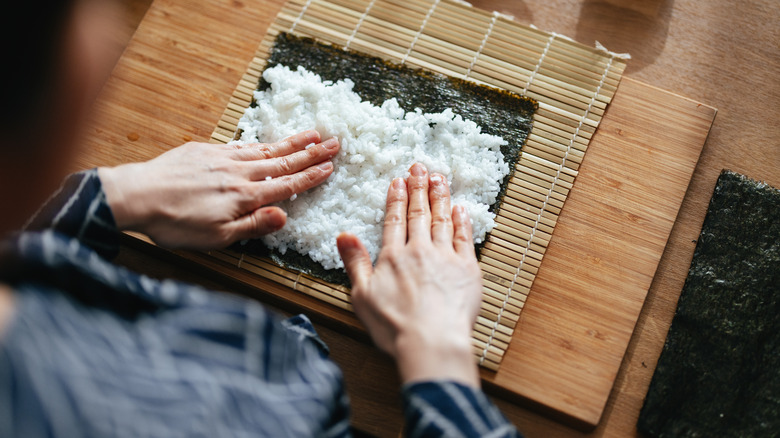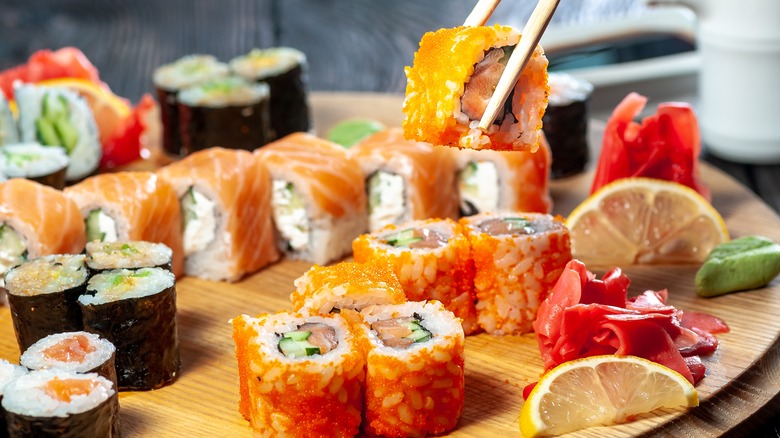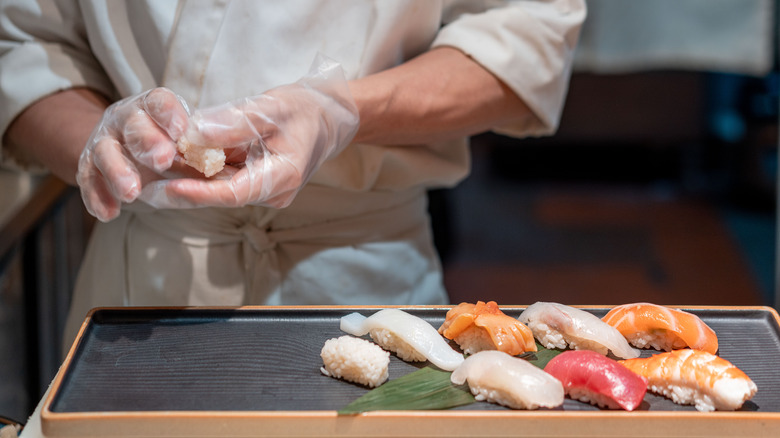Why Grocery Store Sushi Tastes So Different From Restaurant Sushi
A few years ago, a hilariously bizarre musical SNL sketch called Airport Sushi lampooned a customer ordering a container of questionable sushi from an airport kiosk. The sketch went viral as viewers on social media shared their own unfortunate experiences with ready-made dynamite rolls and salmon sashimi. But the fact is, grocery store sushi has gotten pretty darn good. Kroger/Fred Meyer and Albertsons/Safeway locations around the country boast fresh, handmade sushi programs in their deli sections. After flying in consultants from Japan, Costco even launched a fresh sushi platter initiative in 2023, now expanding to locations across the country.
Yet, no matter how fresh and appealing the grocery version can be, it's not the same as noshing on well-made bites of bespoke nigiri or inside-out rolls at your favorite restaurant. There are a number of reasons why store sushi is different, but it essentially boils down to the same reasons any grocery store deli product can't usually compete with restaurant counterparts (think fried chicken). The selection, ingredients, preparation, and specialization are rarely the same.
Here is the biggest difference between grocery store and restaurant sushi
It's important to note that what we in the United States call sushi is a bit different than in Japan. The traditional focus of sushi was and is the rice: seasoned with vinegar and sugar or salt as the star of the dish. Any fish or veggies were essentially an accompaniment. As the dish evolved, other ingredients (including more recent additions like mayonnaise) have taken center stage. Thus dedicated sushi fans may be disappointed from the get-go with grocery store sushi: the rice is cold. Online reviews of even well-received store sushi often call out the sub-par rice.
For National Sushi Day, Iron Chef Masaharu Morimoto shared some pro-level tips for eating sushi, including the right temperature for enjoying it. According to Attractions Magazine, the culinary master said, "Goodbye grocery store sushi case!" He explained that the biggest issue with cold rice is that it loses sweetness, dulling the sushi's complexity, and impacting other ingredients. Refrigerated rice often also dries out, resulting in crumbly or gummy textures. So, if you're grabbing grocery store sushi, try to grab your Dynamite roll as soon as the chef places a new container down. Another approach is simply to embrace this characteristic. After all, next-day cold pizza isn't worse than hot pizza, it's just different.
What kinds of sushi are found at grocery stores
The other significant difference between restaurants and most grocery store counters is the variety of sushi options available. There are many types of preparations that fall under the sushi umbrella. Sashimi is raw fish at its most essential. The fish is prepared, sliced and served. Nigiri features sliced fish (or eel, egg, or what have you) atop a small mound of hand-pressed rice. Maki is what many people often think as sushi: slender cylinders of seaweed wrapped around rice, fish and veggies, cut into disks. Urumaki, designed initially for Americans, reverses the order, so the rice is on the outside, encasing seaweed and filling. And, temaki (and the newer, larger sushi burritos) are hand-rolled cones of seaweed stuffed with the other ingredients.
Most grocery store counters consist of six- or eight-pack containers of maki or urumaki (and sometimes nigiri), with ingredients largely limited to salmon, tuna, imitation crab, and veggie California rolls. Complex rolls popular in America like Dragon, Philadelphia, and Rainbow also sometimes appear. Depending on where you live (especially on the coasts), you may find additional options. But at restaurants, like the iconic sushi spot Nobu, you'll discover far more options. Its New York location's menu features delicacies like eel, sea urchin, and red snapper. Another sushi destination with multiple locations, Blue Sushi Sake Grill, offers sustainably-caught albacore and yellowtail along with vegan options like plant-based tuna and eggplant eel.
Other reasons grocery store sushi is different
It's not only the rice that dries out. That dollops of creamy, neon green wasabi (which likely isn't expensive real wasabi, but a horseradish/mustard mix) can harden and crumble if refrigerated too long. Plus, sushi is best enjoyed when it's around room temperature. So, if you have the willpower, let your container sit out for 15 minutes. Though, don't take this step when sitting outside in hot weather.
Another major difference is the training involved. In Japan especially, the expert chefs train for about a decade. It's likely your neighborhood grocery store chef isn't as intensively schooled. For example, SnowFox, a company that operates over 1,300 grocery store sushi kiosks nationwide, provides its franchisees with a two week training course.
Then there is ambiance to consider. Whether dining at a quiet blonde-wood sushi counter, a kitschy tropical sushi boat restaurant, or a chaotic spot with dancing yuru-chara costumed mascots, it all adds to the enjoyment of the meal. It's difficult to replicate that vibe at your desk. Still, grocery store sushi is a flavorful alternative to the fried deli dishes and cold, pre-made sandwiches you might grab otherwise. You also often get to thank the very person who made your satisfying take-out lunch, a rarity these days.



